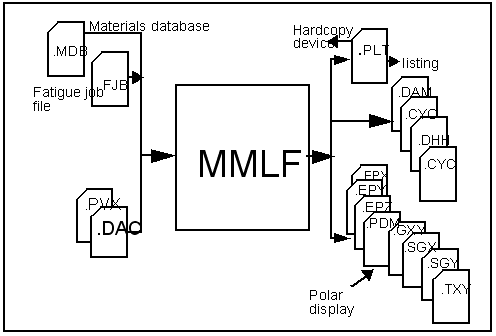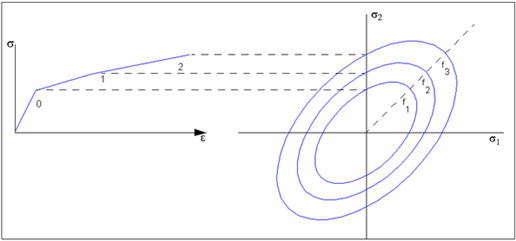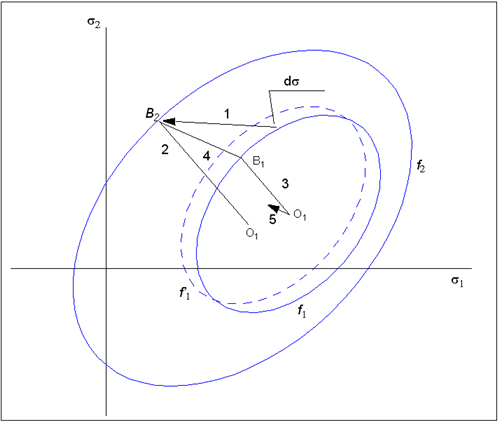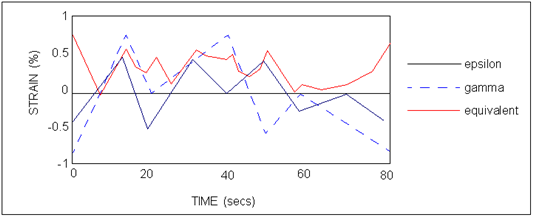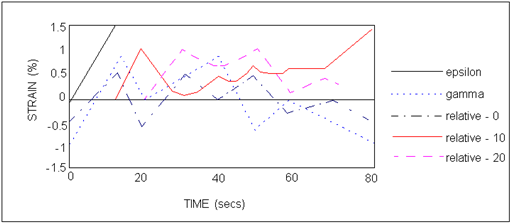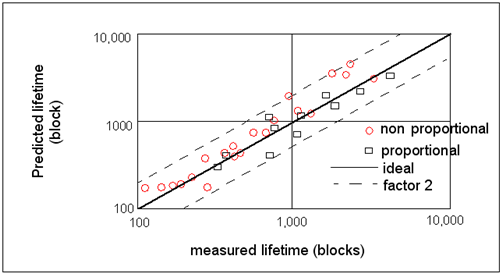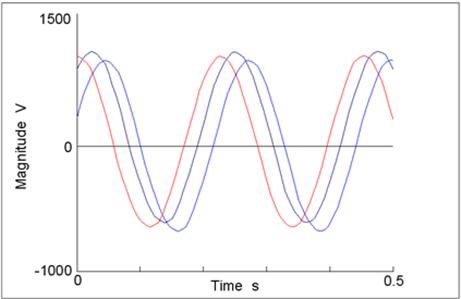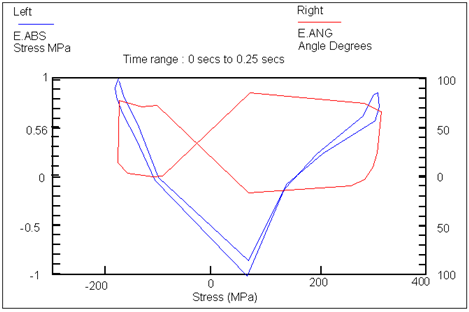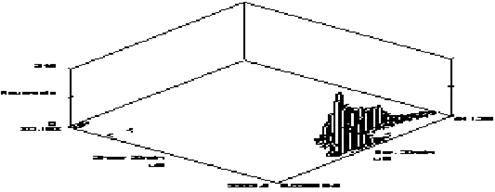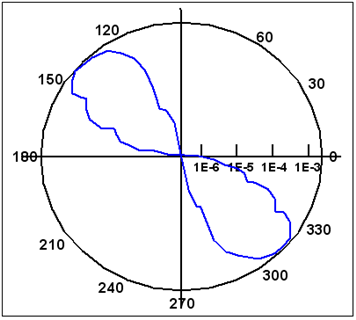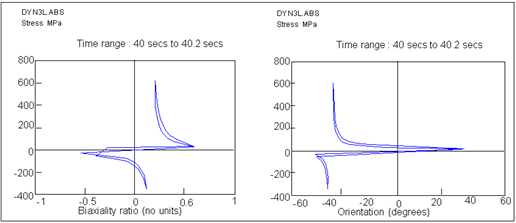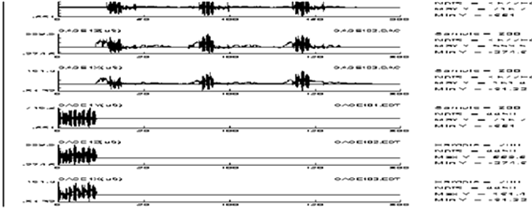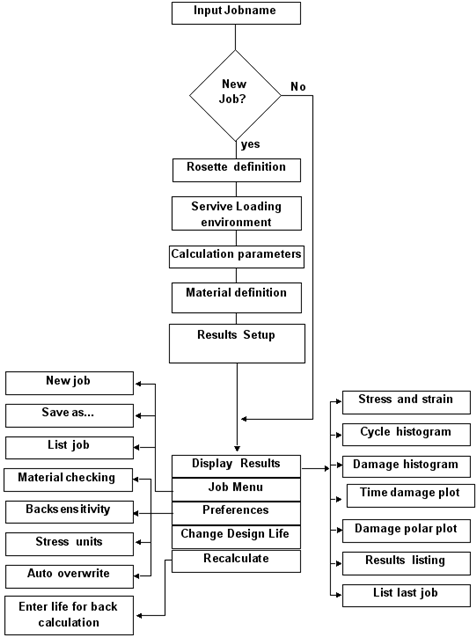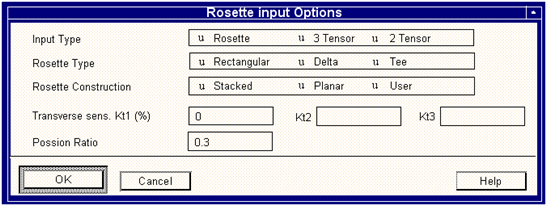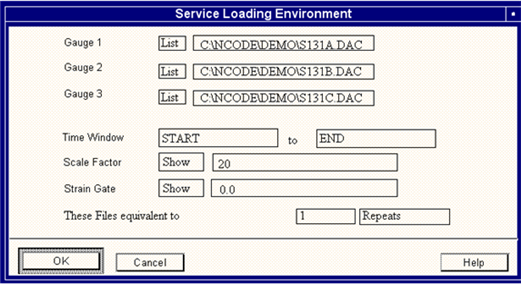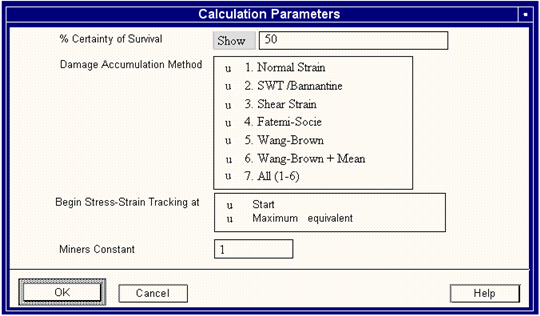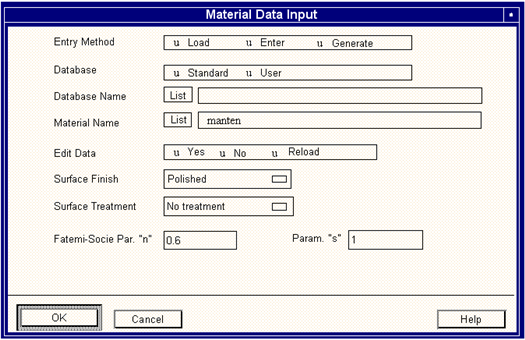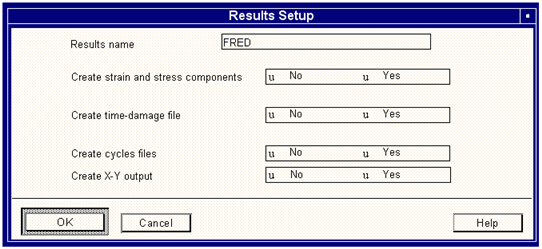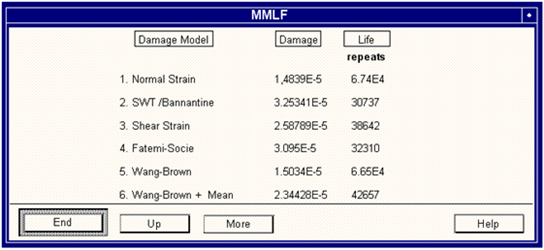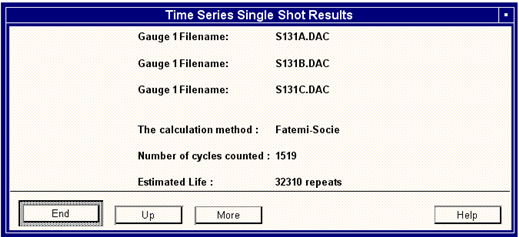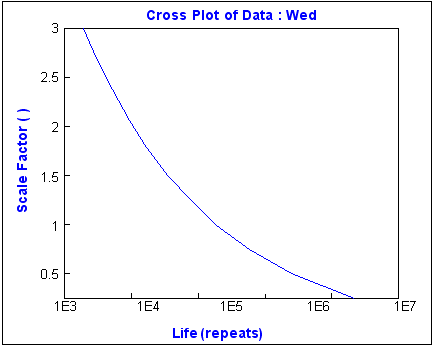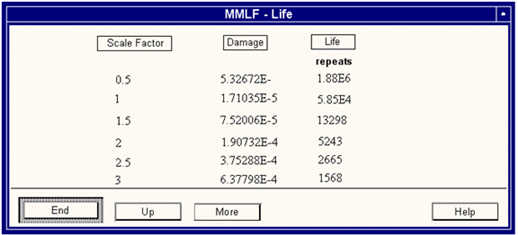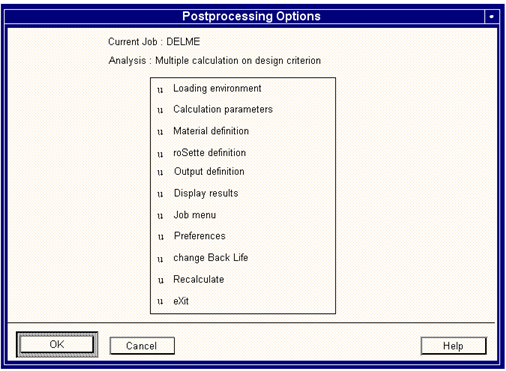XXXXXXXXXXXXXXXXXXXXXXXXXXXXXXXXXXXXXXXXXXXXXXXXXXXXXXXXXXXXXXXXXXXXXXXXXXXXXXXXXXXXXXXXXXXXXXXXXXXXXXXXXXXXXXXXXXXXXXXXXXXXXXXXXXXXXXXXXXXXXXXXXXXXXXXX''"> Local Multiaxial Stress/Strain Fatigue Analyzer (MMLF)
MMLF calculates crack initiation life from data files collected by rosette strain gauges.
MMLF incorporates a Mròz-Garud cyclic plasticity model, together with a generalized form of the Wang-Brown multiaxial rainflow and damage accumulation procedures. The program also incorporates a variety of other critical plane damage models. The program requires measured strains from strain gauge rosettes as input, together with uniaxial cyclic material properties.
The software can handle general non-proportional biaxial loadings.
Summary of Method
Uniaxial methods for life prediction using the local strain approach have been in use for some time, having their roots in the work of Basquin (Ref. 52), Manson (Ref. 53), and Coffin (Ref. 54)(Ref. 55), incorporating rainflow cycle counting and material memory and Miners rule (Ref. 57). Such methods are available in MSC Fatigue. Within the well known limitations of these methods they work quite well for a variety of components where the local loading in the critical area is uniaxial or near-uniaxial. This class of components includes many that are subject to complex multiaxial loading environments (Ref. 49)(Ref. 50). However, there are many other components where a combination of loads and geometric effects generates local loadings which are proportional or non-proportional multiaxial.
The life prediction process from measured strains can be divided into two steps. The first step is to determine the relationship between the measured strains and all the stress and strain components required for the damage calculation, through application of a cyclic plasticity model. The second step is to carry out cycle and damage accumulation. MMLF addresses problems where the strains can be measured with a rosette, i.e. biaxial loading on a free surface. For these problems the process can be summarized by the flow chart in
Figure 6‑6:
Figure 6‑6 Outline of Strain-based Life Prediction Process
The approach for calculations on the basis of elastic finite element analyses will be similar, except that the input strains will be elastic strain components from the surface of the structure, and a notch correction procedure will be required in addition to the cyclic plasticity model to estimate the elastic-plastic stresses and strains (Ref. 59).
The essential calculations made by MMLF are as follows:
1. It takes three strain channels from a strain gauge rosette and convert them to the components of strain
 y
y and

taking into account the transverse sensitivities of the gauge legs. The gauge coordinate system is defined by x parallel to gauge 1 and z as the outward surface normal.
2. It feeds these 3 strain channels into the Mròz-Garud cyclic plasticity model, the outputs of which are the remaining non-zero strain component

and the in-plane stresses

and

.
3. It processes the resulting seven components of stress and strain either by the conventional critical plane methods, or by multiaxial rainflow counting and then accumulating damage using the Wang-Brown methods.
These calculations are described in more detail in the following sections.
Cyclic Plasticity Modeling
The stresses and strains required by the damage models can be calculated if the relation between the equivalent plastic strain increment

and the equivalent stress increment

is known during the application of a given load increment.
However, it is known that the current relation depends on the previous load path and therefore, the plasticity model must deal with loading path dependent material constitutive behavior.
Several models are available in the literature (Ref. 45), (Ref. 46), (Ref. 60), (Ref. 61) of which the model proposed by Mròz and recently modified by Garud are the most popular. Mròz has proposed that the uniaxial stress-strain material curve be represented by a set of plasticity surfaces in three dimensional stress space. In the case of a two dimensional stress state, the plasticity surfaces reduce to ellipses on the plane of principal stresses described by:
(6‑18)

and illustrated in
Figure 6‑7.
Figure 6‑7 Linearization of the Material σ−ε Curve and Corresponding Plasticity Surfaces
The load path dependent memory effects are modeled by prescribing a translation rule for the ellipses moving with respect to each other over distances given by the stress increments. It is also assumed that the ellipses move inside each other and they do not intersect. If the ellipses come in contact with one another they move together as a rigid body.
The translation rule proposed by Garud avoids the intersection of the ellipses that could occur in some cases in the original Mròz model. The Garud translation rule is illustrated in
Figure 6‑8 and can be described by a model consisting, for simplicity, of only two plastic surfaces (ellipses).
Figure 6‑8 Geometrical interpretation of the Mròz-Garud incremental Plasticity Model
In order to predict material response due to the stress increment dσ, the following steps are made:
1. Extend the stress increment dσ to intersect the first external non-active plastic surface f2 at point B2.
2. Connect point B2 and the center of the intersected plastic surface f2.
3. Find point B1 on the active plastic surface f1 by drawing a line parallel to the line O2B2 through the centre O1 of the surface f1.
4. Connect the conjugate points B1 and B2 by the line B1B2.
5. Translate the ellipse f1 in the direction of B1B2 from point O1 until the end of the vector dσ lands on the moving ellipse f1.
The translation rule assures that the two ellipses are tangential with the common point B
1B
2 without intersecting each other. Two or more tangential ellipses translate as a rigid body and the largest moving ellipse (
Figure 6‑8) indicates the proper constitutive relation (linear segment) to be used for a given stress increment. The principal of the method is described here for two surfaces. MMLF uses 40, with the corresponding linear sequences being fitted to the Ramberg-Osgood equation to give a more or less smooth curve. More details of this method can be found in (Ref. 47).
Multiaxial Rainflow Counting
Wang and Brown (Ref. 62) proposed a multiaxial cycle counting method on the basis of strain hardening behavior under non-proportional variable amplitude loading. Relative stresses and strains were introduced so that a pair of turning points define the start and end points of a reversal, where the equivalent relative strain rises monotonically to a peak value. Since plastic deformation generates the driving force for small fatigue cracks, hysteresis hardening provides a physical parameter for cycle counting, analogous to rainflow counting in the uniaxial case.
Each reversal commences with elastic unloading, which is followed by reloading and plastic strain hardening up to the next turning point. The most significant turning point occurs at the highest value of equivalent strain. This is illustrated at time 0 in
Figure 6‑9, which shows a repeating block of a combined tension/torsion non-proportional load history. The equivalent strain is defined as the von Mises strain.
Figure 6‑9 A Variable Amplitude Non-proportional Strain History, Tensile (epsilon), Torsional (gamma) and Absolute Equivalent Strain
The cycle counting method is illustrated by the following example. Starting from the most significant turning point, a graph is drawn for the loading block of relative equivalent strain, where relative strain

represents the change of strain since time A.
Figure 6‑10 shows the relative equivalent strain, with respect to times 0, 10 and 20 seconds. Using the relative strain, a reversal can be defined starting from 0, up to the maximum value 10 seconds. To obtain the second reversal the relative strain is re-plotted starting from the next turning point where unloading commences (at 10 seconds), and the portions of the strain hardening curve for the reversal are selected by a traditional rainflow procedure (Ref. 47). The region of unloading and reloading within that reversal is counted in the next step.
Figure 6‑10 The Variable Amplitude History: Equivalent Strains with Respect to Times 0, 10 and 20
Using the next turning point, relative strain is replotted with respect to 20 seconds for the subsequent continuous fragment of strain history, yielding the third reversal. This procedure is repeated for each turning point in chronological order, until every fragment of strain history has been counted. The recursive nature of this process makes this module significantly slower than other analysis modules such as MCLF.
Fatigue Damage Calculation
The counting method described above is independent of fatigue damage parameters, being based on hysteresis deformation behavior. Being unrelated to material properties, it can be integrated with any multiaxial fatigue damage model. If the counted reversals are non-proportional, a fatigue damage parameter that accounts for non-proportional straining effects is required. The path-independent damage parameter proposed by Wang and Brown (Ref. 63) has been shown to provide good correlation for several materials under proportional and non-proportional loading,
(6‑19)

where γmax is the maximum shear strain amplitude on a critical plane (proportional or non-proportional), δεn is the normal strain excursion between the two turning points of the maximum shear strain (that is the range of normal strain experienced on the maximum shear plane over the interval from start to end of the reversal), and σn,mean is the mean stress normal to the maximum shear plane. This can be omitted if no mean stress correlation is required. If mean stress is included, this is equivalent to the Morrow method. The term S is a material constant determined from a multiaxial test (typically between 1 and 2 for Case A and around 0 for Case B) and v‘ is the effective Poisson’s ratio. The right hand side of the equation is the same as the uniaxial strain life equation, with a Morrow mean stress correction (Ref. 64). Mean stress is measured as the average of the maximum and minimum stress values over the reversal. The total damage induced by a loading history is calculated using Miner’s rule.
Figure 6‑11 is a plot of predicted life against experimental life for a variety of proportional and non-proportional tests on laboratory specimens, from (Ref. 48).
Figure 6‑11 Comparison of Experimental and Predicted Results for the Wang-Brown Method
The other multiaxial damage parameters considered are the more conventional critical plane parameters. In these methods, stresses and strains are resolved onto a particular plane, inclined at an angle

= 90 degrees (Case A) and/or

= 45 degrees (Case B) to the free surface. Cycle counting (uniaxial) and damage parameter calculation is carried out on the critical plane and the damage accumulated. The orientation

of the projection of the normal to the damage plane is increased by 10 degree increments from 0 to 170 degrees. The plane with the largest accumulated damage is said to be the critical plane. The models are:
1. Normal strain (

= 90 degrees only):
(6‑20)

is the strain amplitude normal to the critical plane. Otherwise this is the usual Coffin-Manson-Basquin equation, where

.
2. Shear strain:
(6‑21)

3. Smith-Watson-Topper/Bannantine (

= 90 degrees only) (Ref. 65):
(6‑22)

where

, max is the maximum normal strain on the critical plane which occurs during each rainflow cycle. Otherwise this is the Smith-Topper-Watson method (Ref. 66).
4. Fatemi-Socie (Ref. 67):
(6‑23)

Applications
MMLF may be used to predict the life of components and structures, to provide some help in design optimization, and to assist in the design of efficient tests through fatigue editing. The main drawback of the program is that it is necessary to place a strain gauge rosette on the critical location or crack initiation site in order to get a reliable prediction. This is due to the fact that there is no simple transfer function between the measured strains at a non-critical location and the strains at a nearby critical location when the loading is non-proportional.
Three applications of the multiaxial fatigue program will be described to illustrate the method.
Example 1: Fatigue calculations on an automotive wheel
This example is based on strain gauge measurements from an automotive wheel. The wheel was tested on a rig simulating the rotation of the wheel under load, and the strain gauge measurements were taken using a 45 degree rosette placed in the most critical location. This location was identified by previous stress analysis. A small section of the three strain gauge channels is illustrated in
Figure 6‑12.
Figure 6‑12 Section of Strain Measurements from Wheel Critical Location
The three channels of strain are more or less sinusoidal with a phase difference between them, indicating that the stress state is multiaxial and non-proportional. The two cycles shown above are taken from a longer history. The stress-strain state variations can be better understood qualitatively by looking at the behavior of the principal stresses as illustrated in
Figure 6‑13, where it can be seen that the two principal stresses are almost in phase, but with slightly different amplitudes and means. Notice that the absolute maximum principal stress (the principal stress with the largest magnitude) “flips” between the maximum and the minimum principals. Whenever it does this of course, the angle also flips through 90 degrees indicating that the state of stress has reached a condition where E.MAX and E.MIN are equal and opposite, i.e. pure shear. In fact the stress state behavior can be summed up by saying that when the stress is at a maximum or minimum, the stress state is almost equibiaxial, and in between times it passes through a condition of pure shear where the stresses are lower. Between the two limits the principal stress axis rotates through 90 degrees, so that there is a complete rotation (180 degrees) per cycle. These files were generated using SSA.
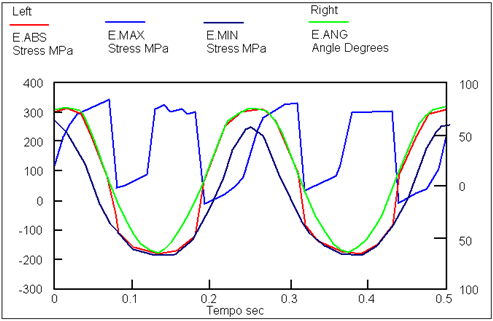
Figure 6‑13 Absolute Maximum (E.ABS), Maximum Principal (E.MAX), Minimum Principal (E.MIN) and Angle of the Absolute Maximum Principal Stress to Gauge 1 Against Time
Figure 6‑14 Plot of Biaxiality Ratio and Angle Against Absolute Maximum Principal Stress
Another way of looking at this data is to plot the biaxiality ratio (the ratio of the smaller in magnitude to the larger principal stress) and the orientation against the largest principal stress. This is shown in
Figure 6‑15 for 1 cycle.
The results of analysis of the full loading history are given below with the results of some other methods for comparison.
Method | Life (Rotations) |
Wang-Brown (S = 1 for Case A, 0 for Case B) | 1.03x106 |
Wang-Brown + Mean (S = 1,0) | 7.07x105 |
Normal Strain | 5.54x106 |
Smith-Topper-Watson (Bannantine) | 9.43x105 |
Shear Strain | 5.95x105 |
Fatemi-Socie (n = 0.6) | 5.17x105 |
Experiment | > 200000 |
| (Test stopped with no failure) |
These results are all very similar, with the notable exception of the normal strain method which is relatively non-conservative.
It is normal to view the accumulated rainflow cycles in an analysis in the form of a 3D histogram plot. Normally the axes are range-mean or max-min or from-to. With the Wang-Brown method, each cycle is characterized by shear strain range, normal strain range, mean normal stress, and two angle

and

. The distribution of numbers of reversals and damage may reasonably be visualized in relation to any two of these parameters.
Figure 6‑15 shows the distribution of reversals in relation to shear strain range and normal strain range.
Another potentially useful way of viewing the results is in the form of a polar plot of damage, as shown in
Figure 6‑16. In this case there are only Case B damaging cycles, so there is only one curve on the plot. This plot was produced with the polar display program MPOD.
Figure 6‑15 One Representation of Rainflow Count.
Figure 6‑16 Polar Plot of Log (damage) Against Orientation φ
Example 2: Fatigue life prediction of a steering rack mounting bracket
This example concerns a sign-off test which is carried out on a front suspension cross-member and steering rack assembly. The steering rack is mounted to the cross-member by means of two small brackets, which are fatigue-sensitive areas. The assembly is tested by fixing the cross-member and applying a constant amplitude, unidirectional load to the steering rack. The resulting stress state variations are illustrated in
Figure 6‑17.
Figure 6‑17 Plots of Principal Stress Ratio (left) and Principal Axis Orientation (right) Plotted Against Absolute Maximum Principal Stress
These plots show that the single-axis loads applied generate locally a near-uniaxial, near proportional stress state. The results of analysis with the new program, assuming 99.9% certainty of survival (based on the calculated standard errors on the material parameters) are as given in below.
Method | Life (Repeats) |
Wang-Brown (S = 1,0 | 24 |
Wang-Brown + Mean (S = 1,0) | 23 |
Normal Strain | 33 |
Smith-Topper-Watson (Bannantine) | 22 |
Shear Strain | 23 |
Fatemi-Socie (n = 0.6) | 23 |
Example 3: Fatigue editing on an off-road vehicle rear axle
This example illustrates how the program can be used to reduce testing times through multiaxial, multichannel fatigue editing of simulation test rig drive files. The component in question is a rear axle from an off-road vehicle. The axle is instrumented with three strain gauge rosettes close to critical locations, and analysis of the measurements from all three strain gauge rosettes show that the loading is non-proportional. It is desired to reduce the testing time by editing the rig drive signals while retaining all the sections of the original sections that cause significant damage. This was carried out using a simple editing procedure.
One of the outputs of the life prediction program is a time-correlated damage file, essentially a time history of damage. This file is a record of the damage accumulated, with damage for each reversal being distributed between the opening and closing point of each reversal. The signal is divided up into a number of equally spaced windows, and the least damaging are discarded until a certain percentage of damage is retained. In this example, 95% was retained. The time slices to be retained are compared across the three channels with a logical OR operation and all the resulting windows are retained. The resulting edit vector can be used to edit the rig drive signals, inserting suitable joining functions for continuity. It is also important to edit the strain signals and recalculate the life in order to check the likely effect of editing on the fatigue damage. This is important because of the possibility of reversals starting in one window and ending in another, and also because in multiaxial loading the loading path is important as well as the peaks. In some cases, editing the signals may actually cause a slight increase in fatigue damage. This is why methods such as described in (Ref. 68) are not really suitable for non-proportional loadings because they do not retain the important sections of the loading path. The results of the analysis described are summarized below and the original and edited strain signals for Gauge 1 are illustrated in
Figure 6‑18.
Gauge Number | Original Signal Predicted Life (repeats) | Edited Signal Predicted Life (repeats) | Actual Damage Retained | Data Reduction Factor |
1 | 13866 | 14079 | 98.5 | 8.25 |
2 | 29770 | 30188 | 98.6 | 8.25 |
3 | 53200 | 53800 | 98.8 | 8.25 |
Figure 6‑18 Strain Signals Before and After Editing
The advantages of this method are that it retains both the most important sections of loading path, and the essential frequency content of the loading, essential for components with dynamic behavior.
MMLF Module Operation
The MMLF module can be run in one of the following 3 modes:
• From the MSC Fatigue Pre & Post Tools menu pulldown
• In stand alone mode by typing mmlf at the system prompt
• By incorporating the MMLF commands in a batch operation
Once running in interactive mode the MMLF module will display the following screen.
Figure 6‑19 The First MMLF Screen
The user must enter the name of an Input Job File, the extension .fjb will be appended automatically. If the name of an existing Job File is entered then MMLF will go to the postprocessing menu screen. If a new job is specified then its parameters have to be entered in a series of windows. If no name is entered then the results of processing may NOT be saved.
If a new job is specified, its name is specified in this window and its parameters in subsequent windows.
The flow chart below illustrates the major routes through MMLF.
Figure 6‑20 The General MMLF Module Structure
The above flowchart is mirrored by the options that are on the Post-processing menu illustrated in
Figure 6‑31. If a new job is being defined, then the following screen will appear.
Rosette Definition
Figure 6‑21 The MMLF Geometry Screen
Field | Description |
Input Type | Input can be either from a Rosetta or from a set of tensor strains (e.g, from FE). |
Rosette Type | MMLF supports three types of rosette configuration: rectangular, delta, and tee. Tee rosettes consist of two mutually perpendicular grids, which should be aligned with the principal stresses. Rectangular rosettes have three grids, with the second and third grids angularly displaced from the first grid by 45 and 90 degrees, respectively. Delta rosettes have three grids, with the second and third grids 60 and 120 degrees away, respectively, from the first grid. See the technical overview of SSA for details. |
Rosette Construction | Strain gauge rosettes are manufactured in two forms, planar, and stacked. Stacked rosettes have the three grids layered on top of each other. Planar rosettes have all three grids laying in the same plane. All the gauges in a stacked rosette have the same gauge factor and transverse sensitivity whilst the grids of a planar rosette will have slightly differing values of these properties. In the latter case, the transverse sensitivities of grids 1 and 3 are generally the same and grid 2 is different. The ‘User’ field allows for the case when all three transverse sensitivities are different. The rosette manufacturer’s data sheet should indicate the type of rosette that the analysis is being set up for. The number of transverse sensitivities (see below) depends upon the choice made in this field. |
Transverse sens. Kt1 (%) | The transverse sensitivity coefficient, Kt, is defined as the ratio of the transverse and axial gauge factors. It is used to correct measured strains for the effects of transverse Poisson’s strains. It should not to be confused with the elastic stress concentration factor of the same name. The number of values to be entered is... • One - Stacked Rosette Configuration • Two - Planar Rosette Configuration • Three - User Defined Rosette Configuration Enter the value of transverse sensitivity coefficient as a percentage. Please refer to the rosette manufacturer’s data sheet for the value(s) of this factor. In practice this may make little difference to the results. |
Poisson’s Ratio | The gauge’s (not the test material’s) Poisson’s ratio (ratio of the fractional contraction in breadth to the fractional increase in length) is entered here. This is the Poisson’s ratio of the material on which the gauge factor was measured. For steel the value is usually 0.285. Please refer to the rosette manufacturer’s data sheet for the required value if different to the default. |
Service Loading Environment
Figure 6‑22 The MMLF Loading Environment Screen
The Service Loading fields are as follows:
Field | Description |
Gauge1 / Gauge 2 /
Gauge 3 | The three files that contain the rosette strain gauge data can be typed individually (or picked using the pick list button) into fields Gauge 1, 2 and 3. |
Time Window | Not all of the Loading Time History file has to be used in the calculation. If only a part of the file needs to be used then the start point and end point can be specified in the Time Window. The default is to use all of the time history file, which is why the defaults are START and END. If a part only is going to be used, then clear the fields and enter the values, i.e. 10 in the Start field and 1000 in the End. Alternatively, the syntax START+n and END-n' where n is a number of units (e.g. seconds) from the start of the file and n' is a number of units before the end of the file. START and END are usually recorded in the header area of the input file. Please note that START is not necessarily zero. |
Scale Factor | The scale factor is an amount by which the history will be multiplied. Multiple scale factors can be entered. For example entering (-500,1000,50) in the field will scale from -500 to +1000 inclusive in steps of 50, i.e. from to in steps of
-500, 1000, 50 BACK may also be entered in which case MMLF will calculate the scale factor needed to achieve the required design life. See the online help for further examples of multiple entry and arithmetic operations with keywords. |
Strain Gate | The gate is, in effect, a filter that may speed processing by filtering any small cycles that are unwanted (for example signal noise). The gate value should not be set too high or it will filter out relevant parts of the signal. Any signal smaller than the gate value specified in this field will be ignored in the life calculation. Multiple gate values can be entered using the same syntax as the example given for scale factors (above). No results file will be saved if a multiple analysis is carried out. A multiple gate analysis can be used to assess the gate value so that the user can choose the gate threshold that just fails to remove genuine damaging events. The gate threshold value is sensitive to changes in material. Also if a signal is scaled up by 2 the gate is NOT automatically scaled up by 2, the user must manually scale up gate. |
These files equivalent to.....repeats | The fatigue analysis to be carried out is through the use of a either a time series, range-mean matrix or a sequence of peak valleys. The results will normally be presented in the form of the number of repeats of these series to failure. An equivalent unit, such as miles, laps, hours, etc. can be attached to the input loading file so that results can be presented in the form of miles, laps or hours to failure. In these fields, enter the units laps, and the number of them that the loading series is equivalent to. Note that the units and their number will be stored within the extra details area of the input data file using EQUUNITS and NUMEQUNI as keywords respectively. |
Note: | Only 1 field from Scale Factor, or Strain Gate (see below) can have multiple values entered. Attempts to enter multiple values in more than 1 of these fields will result in an error message. This limitation also affects the % Certainty of Survival field on the Calculation Parameters screen or any field with a SHOW button. |
Model Parameters
Figure 6‑23 MMLF Model Parameters
The fields are as follows:
Field | Description |
% Certainty of Survival | Any fatigue life prediction has associated with it a degree of uncertainty. To incorporate the effects of scatter in the strain life data, a % certainty of survival value can be entered here. This option is similar to that in any other MSC Fatigue module. |
Damage Accumulation Method | MMLF supports 6 multiaxial damage accumulation methods. Options 1 - 4 are conventional critical plane methods, whereas options 5 and 6 are more sophisticated and are described in more detail in the technical background. The conventional critical plane methods work by calculating the normal or shear strains and normal stresses on a particular plane, before carrying out cycle counting and damage accumulation more or less in the normal way. The orientation of the plane is defined by 2 angles θ and φ. The angle θ is the angle made by the free surface normal and the normal to the current plane. The angle φ is the angle made by the projection onto the free surface of the normal to the plane and the local x-axis (gauge 1). A variety of angles are calculated and the one with the worst damage is taken to be the critical plane. Because the damage parameters are essentially either normal strain or shear strain based, q takes values of 90 (Case A) or 45 (Case B) degrees. The angle θ can take any value in theory. In the program θ is increased in increments of 10 degrees. If only case A is calculated, as in options 1 and 2, 18 planes are evaluated. Otherwise, 36 planes are considered. The Wang-Brown and Wang-Brown + Mean are considered the best of these methods. If you have a uniaxial loading with no mean stress, all these methods will give almost the same result. The methods are described below this table. |
Begin Stress-Strain Tracking at | The Wang Brown method of cycle counting always starts from the maximum equivalent strain. If you wish to start the stress strain tracking from this point also, then select Maximum equivalent. This is better as it minimizes the effect of transient behavior at the beginning of the strain history. Otherwise select Start to begin stress-strain tracking from the start of the strain history file. |
Miners Constant | You can adjust Miner’s constant as with other MSC Fatigue modules. See the comment below regarding Miner’s rule. |
The damage accumulation methods are:
1. Normal Strain
This is a simple “critical plane method”. The damage parameter is the normal strain εn used in conjunction with the Coffin-Manson-Basquin equation.
2. SWT/Bannantine
This method is very similar to the normal Smith-Watson-Topper method. In additional to the normal strain, the damage parameter includes the maximum normal stress

. This is the maximum normal stress occurring in each rainflow cycle. The difference with the normal SWT method is that the maximum normal stress does not necessarily occur at the same time as the maximum normal strain.
3. Shear Strain
The shear strain method is similar to the first option, except that it uses shear strain only, and the parameters

and

are modified accordingly.
4. Fatemi-Socie
The Fatemi-Socie method uses shear strain and maximum normal stress. Note that it requires two extra parameters: the yield stress of the material and a dimensionless parameter n. Make sure you have defined a yield stress for the material if you want to use this method. These parameters effectively control the relative importance of the shear strain and the normal stress. Typical values of n are from 0.4 to 0.6.
5. Wang-Brown, and
6. Wang Brown + Mean
These methods are described in more detail in the
Summary of Method, 406.
Regarding Miner’s constant, operation at a strain amplitude

will result in failure in, say, N
1 cycles. Operation at the same strain amplitude for a number of cycles less than N
1, N
j say, will result in a smaller fraction of damage, D
j, which is often referred to as a partial damage. Operation over a spectrum of different strain levels, results in a partial damage contribution D
i from each strain cycle,ε
i. Failure is then predicted when the sum of these partial damage fractions reaches unity so that:
D1 + D2 +...... + Di-1 + Di ≥ 1
The Palmgren-Miner rule asserts that the partial damage at any strain amplitude

, or STW level, is linearly proportional to the ratio of number of cycles of operation, n
i, to the total number of cycles that would produce failure at that strain level, N
i i.e.:
Di = ni / Ni
Failure is predicted then if:
or

The above equations represent a statement of the linear damage rules used by all the MSC Fatigue analyzers. Experience shows that linear damage summation is somewhat of an over-simplification of reality. The most important shortcoming is that no account is made of the sequence in which strain levels are experienced, and damage is assumed to accumulate at the same rate for a given strain level regardless of prehistory. In particular, it appears that large strain amplitudes which precede smaller ones, cause the smaller cycles to become more damaging than expected and visa versa. The net result is that in the first instance, the Miners' sum (total of (n/N)) is measured to be less than 1 and in the latter case, it becomes greater than 1. Since most service environments involve quasi-random loading sequences, the use of the Palmgren-Miner linear damage rule summing to a constant of 1 is mostly satisfactory. However, provisions have been made within MMLF to set the Miners' sum to any desired value.
Material Data Input
Figure 6‑24 The material Data Input screen
The multiaxial local stress-strain fatigue analyzer requires a characterization of the material from which the component or part is manufactured. This characterization is accomplished through a set of parameters generated by strain-controlled testing smooth specimens of the material in question.
This screen allows selection of material data-sets to be made. It is possible to either load the desired parameters from the PFMAT data base, to load them from a user custom database (any name allowed) or to enter them directly from the keyboard, or to generate them from empirical rules based on tensile properties.
Field | Description |
Entry Method = Load | Selecting this option allows data-sets to be loaded directly from the material database. |
Database | Allows you to specify the database from which materials parameters will be extracted. The default is to look for a local database called NMATS.MDB. If the User option is selected, then a database name must be specified. |
Database Name | Specify the name of the database to use. |
Material Name | Material data-sets are loaded directly from the material database. Each data-set has a unique name through which it can be referenced. The PICK LIST button, can be used to list all the available data-sets and the cursor used to pick the required set. The data base manager, PFMAT, can also be used to search for materials with specific characteristics. The search operation needs to be carried out outside this program, perhaps in multiaxial mode. |
Edit Data Yes/No/Reload | Having selected a material data-set from the database, it is possible to edit the parameters prior to a life estimation. Select yes if you require to edit the material parameters prior to (re)calculation. The edit function itself will be present on exit from this screen. Select reload to undo any previous edits by reloading the named material from the database. |
Entry Method = Enter | Material data parameters may be entered directly from the keyboard. The parameters entered will be loaded into the job file and remain active until overwritten or another job selected. They will NOT be loaded into the PFMAT database. If a particular set of parameters is to be used often, then it is recommended that they be loaded within the database by running PFMAT. To enter parameters, move the highlight cursor to the required position and enter the value in the appropriate units. Stress units can be customized in the preferences menu. All of these parameters are described in Material Management (Ch. 3). |
Entry Method = Generate (Material Parameters) | Selecting this option will send the user to a separate Material Data Generation screen that prompts the user to enter the data needed to generate a data set. The form in Figure 6‑25 is displayed and the various field are explained in the table that follows the figure. |
Surface Finish | This field is provided because surface finish can have a significant effect upon fatigue life, especially with higher strength materials. The default entry is 'Polished' as with a laboratory specimen, but a whole range of predefined finishes is provided. The surface finish correction factors that will be applied to the calculation are held in the /mats sub-directory. Selecting User Defined enables the user to define a surface correction factor. Selecting all will cause MMLF to calculate the fatigue lives for the whole range of Surface Finishes. |
Surface Treatment | Treatments that introduce stresses, usually compressive, into the surface of a component have a significant effect upon fatigue life. Correction factors for a range of surface treatments are therefore available within MMLF. Selecting ALL will cause MMLF to calculate the fatigue life for the entire range of surface treatments. 'All' can NOT be entered for both Surface Finish and Surface Treatment at the same time. |
Fatemi-Socie Parameter “n” | The Fatemi-Socie method requires two parameters to be defined which are not normally required for a fatigue analysis, namely the yield stress of the material and a dimensionless parameter n. The value of n/σy controls the relative importance of the maximum normal stress and the shear strain range for the damage parameter. |
Material parameter “s” | The Wang-Brown method uses a damage parameter  . The parameter S controls the relative importance of the shear and normal strain range on the critical plane, for Case A only. For Case B, S is set to 0. In general values of S are in the range 1 to 2. A value of 1 will tend to be a little conservative, so is a reasonable default. |
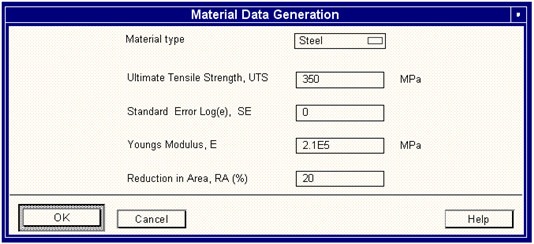
Figure 6‑25 Generating a Materials Data Set
Field | Description |
Material Type | Steel, Titanium, Aluminum, Other |
Ultimate Tensile Strength (UTS) | Enter a value for the UTS in the units specified. The parameters required to characterize cyclic material properties can be generated purely on the basis of this field. |
Standard Error of Log(ε) - SE | Enter a value for the standard error of log(ε). The value will apply equally to the elastic life line, the plastic life line, and the cyclic stress strain curve. |
Youngs Modulus - YM | Enter a value for the modulus of elasticity (Young's modulus) in the units specified. This field only appears for Material Type = Other. |
Reduction in Area - RA % | Enter a value for the percentage reduction in area. This field only appears for Material Type = Other. |
Regarding surface finish and treatment: the effect of surface treatment depends on the surface finish. The increase in endurance limit with stress due to the surface treatment is given below.
:
FINISH | SHOT PEENED | COLD ROLLED | NITRIDED |
Polished | +15% | +50% | +100% |
Ground | +20% | +0% | +100% |
Machined | +30% | +70% | +100% |
Hot Rolled | +40% | +0% | +100% |
Cast | +40% | +0% | +100% |
Forged | +100% | +0% | +100% |
Whatever correction was made by the surface finish, then applying a surface treatment will have a subsequent effect taken from the table above. For example if machining reduces the endurance limit by 50%, and it is wished to recover the loss, then from the table it can be seen that cold rolling will increase the limit by +70%.
Results Setup Screen
Figure 6‑26 Results Setup Screen
The output files generated by any of the combination of settings to which MMLF can be set are shown below. Note that the files generated in any given run of MMLF depend upon the parameters specified in the job file.
Extension | File definition |
.cyo | Three parameter cycles file |
.cyc | ASCII reversals file (Wang-Brown only). It has 11 columns of data (shear strain, angle φ etc.) which can be viewed in a text editor or a spreadsheet. |
.dam | Single parameter time correlated damage file |
.dhh | Three parameter damage histogram |
.epy | Y-component direct strain |
.epx | X-component direct strain (parallel to gauge 1) |
.epz | Z-strain (surface normal) |
.gxy | XY-shear strain (engineering) |
.pdm | Polar plot of damage at different critical planes (angle φ) |
.sgx | X-component stress |
.sgy | Y-component stress |
.txy | XY shear stress |
MMLF can generate a number of different output files depending on the analysis path chosen. If a multiple analysis has been specified in any of the input screens, then a single file, with the results name provided with any one of the following file extensions, depending on the multiple parameter, will be created.
.fal | Scale factor vs. Life |
.dcl | Survival probability vs. Life |
.gal | Gate vs. life |
All these files have the standard X-Y paired data format and can be displayed graphically within MMLF itself or by the X-Y parameter display module, MTPD. No other output files will be created.
If, on the other hand, a single shot analysis has been carried out then MMLF can optionally create a group of files which contain different information, have the same results name and the following file extensions.
.cyo | rainflow matrix suitable for input to MCDA or MP3D |
.cyc | ASCII cycles file |
.dhh | damage matrix suitable for input to MP3D |
.pdm | data file of damage/angle suitable for plotting with MPOD or MTPD |
.ep | strain component |
.epy | strain y-component |
.epz | strain z-component |
.gxy | strain xy-component |
.sgx | stress x-component |
.sgy | stress y-component |
.gxy | stress xy-component |
In addition, numerical results are written to the extra details area of the damage matrix file, .dhh extension. The following table details the keywords and values stored.
Keyword | Value | Description |
ANALYSIS | MLF | Program responsible for analysis |
METHOD | Wang-Brown+Mean | Mean stress correction method |
DCRIT | 50.0 | Probability of survival used |
FACTOR | 1 | Scale factor |
GATE | 0.0 | Hysteresis gate used |
MINER | 1 | Miner's constant used |
MATERIAL | MANTEN | Material used |
EQUUNITS | Repeats | Equivalent units |
NUMEQUNI | 1 | Number of equivalent units |
UTS | 552 | Ultimate tensile strength of material use |
$CYCHEXT | 5161.CYO | Rainflow matrix id, for system use only |
MEANLF | 333 | Mean life calculated |
Figure 6‑27 Results of a Single Shot Analysis (All Methods)
Figure 6‑28 Single Shot Analysis of Just One Method
The fatigue life represents the number of repeats of the history to failure. In this context “failure” is taken to be that defined to be the initiation of an 'engineering crack', typically 2mm. The number of cycles or reversals used corresponds to the number of cycles or reversals in the strain record.
The Results From a Multiple Analysis
If a multiple analysis procedure has been specified then, on completion, MMLF will display a table of results on the screen and make a similar entry to the notebook and generate an X-Y file of results. In the case of a certainty of survival analysis, entering ALL in response to the question, and introducing scatter (e.g. SD=0.2 in the materials data edit screen), will cause the following table to be displayed:
Design criterion vs. Life analysis |
Number of SD's from mean | % Certainty of survival | Design life (repeats of history) |
-3 | 99.9 | 1164 |
-2.5 | 99.4 | 1486 |
-2 | 97.7 | 1902 |
-1.5 | 93 | 2437 |
-1 | 84 | 3129 |
-0.5 | 69 | 4024 |
0 | 50 | 5185 |
0.5 | 31 | 6698 |
1 | 16 | 8674 |
An example of an X-Y plot is shown below.
Figure 6‑29 Plot of Design Criterion vs. Life
Figure 6‑30 A Multiple Analysis Results Listing
The Postprocessing Menu
The general module structure flowchart in
Figure 6‑20 at the start of the Module Operation section illustrates how MMLF will always lead the user to the Postprocessing Menu.
The Postprocessing menu looks like this:
Figure 6‑31 The Postprocessing Menu
The menu shown above can be mapped directly to the flow chart in
Figure 6‑20.
The Postprocessing options screen will be reached when:
• all of the parameters of a new job have been entered and the calculation has been carried out.
• a predefined job was entered as the Jobname (see Figure 6‑19). In which case the job definition screens will be skipped. The Postprocessing menu allows a job to have one or more of its parameters changed, and to have existing results and parameters changed and/or viewed.
Note: | If any parameters are changed, the Recalculate option must be run for the changes to take effect. |
The options on the menu that allow current inputs to be altered are:
Field | Description |
Loading Environment | Returns control to the loading environment screen (see Figure 6‑22). |
Calculation Parameters | Returns control to the Model parameters screen (see Figure 6‑23). |
Material Definition | Returns control to the Material Definition screen (see Figure 6‑24). |
Rosette Definition | Returns control to the Rosette Definition screen (see Figure 6‑21). |
Output Definition | Returns control to the Results Setup screen (see Figure 6‑26). |
The other options may or may not affect the results of the calculation, but are generally of the nature of utilities rather than calculation parameters. They are as follows:
Display Results
This displays the results of the most recently calculated life estimation. Exactly what is available for display depends upon the calculation; if an X-Y file was not created then it cannot be displayed, a multiple calculation will not produce any histogram files, but will produce an X-Y plot, etc.
Essentially this option plots the 7 non-zero stress and strain components. These are:
.sgx - σx(t), .sgy - σy(t), .txy - σxy(t), .epx - εx(t), .epy - εx(t), .epz - εz(t), .gxy - γxy(t)
The full range of possibilities is explained below:
Option | Description |
Stress and Strain
(X-Y Plot) | Display a two parameter plot from a multiple analysis. MMLF actually loads the two parameter display module MTPD for this type of display. |
Cycle Histogram | Display a rainflow cycles or reversals matrix file as a 3D plot. Such a file may have been calculated or entered into the analyzer. MMLF actually loads the plot 3D module MP3D for this type of display. If a damage matrix file (. dhh) was also created during the current analysis it can also be loaded from within MP3D. See Matrix Options, 318. For option 1 and 3 the histogram is stress range, mean stress, cycles. For option 2 and 4 the histogram is strain range-mean, max stress, cycles. For option 5 and 6 the histogram is strain range, normal stress range, reversals. |
Damage Histogram | Display a damage matrix file as a 3D plot. MMLF actually loads the Plot 3D module MP3D for this type of display. If a cycles matrix file (. cyh) was also created during the current analysis it can also be loaded from within MP3D. See Matrix Options, 318. |
Time-damage Plot | Displays the original input strains, together with a time-correlated damage plot. See , 1095. |
Damage Polar Plot | This option displays a polar plot that shows log (damage) against orientation φ. The plot is created for the . pdm file, which is a two parameter file. Case A and B damage are plotted separately. See Polar Display (MPOD), 784. |
Results Listing | This option will list the full results of the current life estimation in tabular form, i.e. not as a graphic. Such listings are carried out within MMLF. If parameters have been changed but not Recalculated, then the unrecalculated data will NOT be listed. |
List Last Job | This option will list the full set of parameters used for the current life estimation, in tabular form, i.e. not as a graphic. Such listings are carried out within MMLF. If parameters have been changed but not Recalculated, then the unrecalculated data will NOT be listed. |
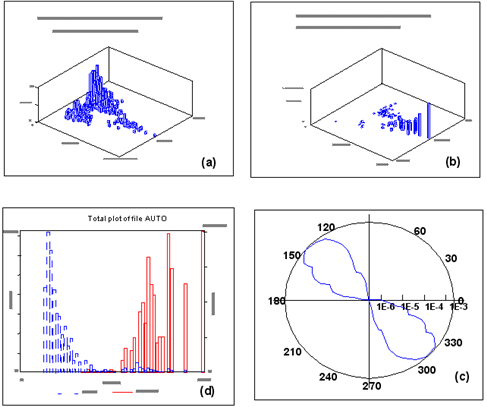
Figure 6‑32 Sample MMLF plots. Cycles (a), Damage (b), Polar Plot (c),
and Damage Analysis (d)
Job Menu
The Job utilities menu has three options:
Option | Description |
New job | Will send the user to screen 1 of MMLF where a new job can be defined. |
Save job as | Will save the current job under a new name. The current job remains active. This option is useful for preserving the current job before changing it. |
List job | Will list all of the details of the current job (but not the life estimation results). |
Preferences
The personal preferences menu allows some aspects of MMLF's operation to be customized. These are:
Option | Description |
Material checking | MMLF normally checks material parameters to ensure that they are within certain limits. Such limits ensure that the numbers are within expected ranges, and also trap numbers that may cause arithmetic errors, e.g., the log of a negative number. Such self-checking can be turned off if required. |
Back sensitivity | BACK calculations are iterative life estimations which determine the value of certain parameters necessary to achieve a specific life. Normally MMLF considers the calculated life to be estimable to within 5%. This assumption can be altered with this option. |
Stress Units | The units in which material parameters are displayed can be selected from a submenu from this option. |
Auto-overwrite | This option can be used to specify if existing output files are to be automatically overwritten by new files with the same name. Auto-overwrite=Yes should be used with caution because it suppresses the Overwrite Existing file Yes/No warning, and may cause a loss of data. On the other hand, it can save a lot of disk space. |
Curve method | MMLF creates a stepwise cycle stress strain increment table for the plastic section of the curve based on Ramberg-Osgood.
The method of curve creation can be selected with this option. |
Change Back Life
Allows a value to be entered for the life of the back calculation.
Note: | A back calculation may fail if the target life is greater than the cutoff point of the S-N curve or strain life curve currently being used. So exercise caution when specifying large numbers as the target for back calculation e.g. >1E5. |
Recalculate
In order to see the results of any change to the parameters in a job file, this option must be selected. Until this option is selected any changes will be ignored, and the job and results files will not be updated.
eXit
Exits from MMLF.
MMLF Environment Keywords
MMLF writes or reads the following entries to or from the local user environment.
Writes | | Reads | |
.MLFFJB | last job file | PFSTUNI | match units |
$PAIRED | last X-Y file | BACKTOLR | back life calculation tolerance |
$LASTPRG | last program | MATCHECK | default status of material checking |
$HISTOG | last histogram file | FATAUTOV | default status of auto-overwrite |
.CYH | last cycles histogram file | | |
MMLF Batch Operation
It is recommended that, by default, the /OV=Y keyword be included in every batch command line, since if it is omitted and an output file with the specified name already exists, batch operation will cease. To finish an MMLF batch line use /OPT=X to exit from the postprocessing screen.
When batch processing with a series of different inputs, it is necessary to use a new batch line and option definition for each new input. The new line must specify the option from the postprocessing menu into which the new input will go.
A list of MMLF’s batch keywords:
/JOB | Job File name |
/CREate | Confirm Creation of New Job. Y,N |
/STYPE | Strain Type. M,E |
/FTYPE | File input method. I,G |
/IINP1,/INP2,/INP3 | Input file names |
/GEN | Generic file name |
/CHA | Channel numbers |
/EQUNITs | Equivalent Units |
/NUMEQUnits | Number of Equivalent Units |
/STArt | Start Time for Analysis |
/END | End Time for Analysis |
/GATE | Strain cycle gate |
/FACTor | Scale Factor for input Loading |
/MATENTry | Mode of Material Parameter Entry. L,E,G |
/MATSRC | Source of materials data. S,U |
/DBNAME | Material Database Name |
/MATname | Material Parameter Dataset Name |
/EDIT | Edit Material Dataset. Y,N |
/FSP | Fatemi-Socie Parameter |
/BMP | Brown-Miller Parameter |
Parameter Editing & Entry: |
/UTS | Ultimate Tensile Strength |
/YM | Young's Modulus |
/YS | Yield Strength |
/SF | Fatigue Strength Coefficient |
/BASQ | Fatigue Strength Exponent |
/EF | Fatigue Ductility Coefficient |
/COFF | Fatigue Ductility Exponent |
/NP | Cyclic Hardening Exponent |
/KP | Cyclic Hardening Coefficient |
/CUTOFF | Endurance Limit Cut-off |
/SERRE | Elastic Standard Error |
/SERRP | Plastic Standard Error |
/SERRC | Cyclic Standard Error |
/RATIO | R - Ratio |
Parameter Generation: |
/GENTYP | Generic Material Type. S,A,T,O |
/UTS | Ultimate Tensile Strength |
/SERR | Standard Error of Log strain |
/RAREA | Reduction in Area |
/SURFace | Surface Finish - POLished, GRound, GOod Machined, Average Machined, POOrly Machined, HOt Rolled, Forged, Cast, Water Corroded, Sea Corroded, User-Defined |
/TREATment | Surface treatment - None, Nitrided, Cold rolled, Shot peened, All |
Calculation Parameters: |
/DESign | Design Criterion Percent |
/METHod | Damage accumulation method. 1-7 |
/MINERs | Value of Miner's Constant |
/ANSTArt | Start point for stress-strain tracking. S,M |
/TYP | Rosette Type. R,T,D |
/CON | Rosette Construction. S,P,U |
/KT1,/KT2,/KT3 | Transverse sensitivity |
/POIS | Poisson’s Ratio of Gauge |
/OUTput | Generic Name for Output Files |
/OPTion | Postprocessing Options. L,C,M,S,O,D, J,P,B,R,X |
/RESOPTion | Results Display Options. S,C,D,T,O,R,J |
/JOBOPTion | Job File Options. N,S,L |
/PRFOPTion | Preference Options. M,S,B,A |
/UNIOPTion | Units Options. MP,P,K,N,MN |
/NEWJOB | Start Another Job. Y,N |
/LIFE | Life required for Back Calculation |
/MATCHK | Material Parameter Checking. Y,N |
/TOLER | Sensitivity of Back Calculation |
/OVerwrite | Overwrite Existing Output Files. Y,N |
/AUTOVerwrite | Overwrite Without Confirmation. Y,N |
/PLOt | Whether hardcopy is required. Y,N |
/PLTNAM | Hardcopy file name |
